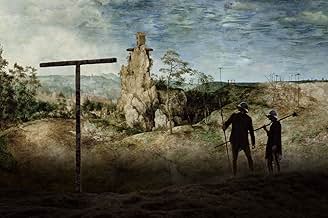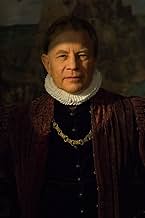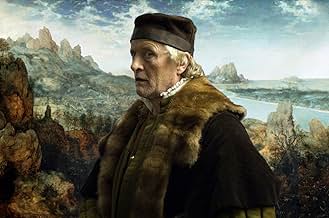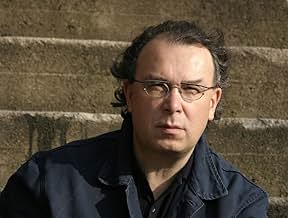CALIFICACIÓN DE IMDb
6.8/10
4.5 k
TU CALIFICACIÓN
Agrega una trama en tu idiomaThis movie focuses on a dozen of the five hundred characters depicted in Bruegel's painting. The theme of Christ's suffering is set against religious persecution in Flanders in 1564.This movie focuses on a dozen of the five hundred characters depicted in Bruegel's painting. The theme of Christ's suffering is set against religious persecution in Flanders in 1564.This movie focuses on a dozen of the five hundred characters depicted in Bruegel's painting. The theme of Christ's suffering is set against religious persecution in Flanders in 1564.
- Dirección
- Guionistas
- Elenco
- Premios
- 10 premios ganados y 7 nominaciones en total
- Dirección
- Guionistas
- Todo el elenco y el equipo
- Producción, taquilla y más en IMDbPro
Opiniones destacadas
The Mill and the Cross (2011)
Maybe I anticipated this for too long, hearing about its production, and teaching in an Art History department myself. The result is both astonishing and boring as heck. I know, there is a kind of absorption that happens through silence and slow appreciation. And there is even the astonishment of looking without really thinking, or feeling, for the narrative or the characters.
This is, for sure, a visually wonderful movie. The way it works out the scenery and milieu of a period based on a single painting is brilliant and ambitious. The mise-en-scene might in fact be the only and singular point of it all. So on that level, eleven stars. Terrific. Mind-blowing.
But that exercise in naturalistic re-creation, in enlivening a masterpiece on canvas by Bruegel from 1564, is not, to me, enough. You will know after ten minutes whether to continue. I have heard of people being just spellbound by it all, so that hopefully would be your feeling.
I tried to make the characters have meaning on some level, either in their interactions, or in their actions alone, or through what they did to the world around them. Much of what happens feels more medieval than Renaissance, to me, but I'm sure that was researched thoroughly. (Bruegel was painting at a time when the Renaissance from Italy had made its way thoroughly north to the lowland countries and beyond.)
It is fun (and indicative of the seriousness here) that both Michael York and Charlotte Rampling took part, late in their careers. That was one of the draws, for sure. But don't expect revelations there, either. Expect in fact only what the director, Lech Majewski, intended—a film version of the painting, set in its larger context but always based on and drawing from this one admittedly fantastic painting. Which might be your starting point, before launching into this one and half hour homage.
Maybe I anticipated this for too long, hearing about its production, and teaching in an Art History department myself. The result is both astonishing and boring as heck. I know, there is a kind of absorption that happens through silence and slow appreciation. And there is even the astonishment of looking without really thinking, or feeling, for the narrative or the characters.
This is, for sure, a visually wonderful movie. The way it works out the scenery and milieu of a period based on a single painting is brilliant and ambitious. The mise-en-scene might in fact be the only and singular point of it all. So on that level, eleven stars. Terrific. Mind-blowing.
But that exercise in naturalistic re-creation, in enlivening a masterpiece on canvas by Bruegel from 1564, is not, to me, enough. You will know after ten minutes whether to continue. I have heard of people being just spellbound by it all, so that hopefully would be your feeling.
I tried to make the characters have meaning on some level, either in their interactions, or in their actions alone, or through what they did to the world around them. Much of what happens feels more medieval than Renaissance, to me, but I'm sure that was researched thoroughly. (Bruegel was painting at a time when the Renaissance from Italy had made its way thoroughly north to the lowland countries and beyond.)
It is fun (and indicative of the seriousness here) that both Michael York and Charlotte Rampling took part, late in their careers. That was one of the draws, for sure. But don't expect revelations there, either. Expect in fact only what the director, Lech Majewski, intended—a film version of the painting, set in its larger context but always based on and drawing from this one admittedly fantastic painting. Which might be your starting point, before launching into this one and half hour homage.
The Mill and the Cross is a painting (so not a lot of plot!) come to life and it is unlike any movie I have ever seen before (and I have seen a few)! Directed by Polish filmmaker, Lech Majewski, it is a recreation and interpretation of the famous 1564 painting by Pieter Bruegel, "The Way to Calvary".
Glacially-paced and nearly-silent (at first) ... one film critic (Stephen Cole of "Globe and Mail") said that this film's detractors will likely lament that watching this "is like watching a painting dry" (a point I can understand some having). If it doesn't grab one's interest early-on -- the film's opening is the painting coming to life and than slowly drying back onto the canvas -- there is no point in watching it.
Another film about the inspiration of a painting (that I loved) -- The Girl with the Pearl Earring -- told a possible story of how a Vermeer masterpiece came into being AND each scene was as lovely as a painted picture. Here each scene looks like a painting as well; but this story isn't necessarily one about a "what-if" (although as a film it technically is). Instead, The Mill and the Cross pretends to show us THIS painting (not the inspiration behind it) as it is being painted.
The painting is of the re-imagined crucifixion of Christ in 16th Century Flanders while the region is under BRUTAL Spanish occupation. As Bruegel (Rutger Hauer - Batman Begins, Hobo with a Shotgun, Blade Runner) draws and explains his painting, the scene comes to life so that the audience sees what Bruegel "sees". The premise and style are highly unusual but I appreciated the delicate take (layer-upon-layer of computer imaging) of telling this story.
The Mill and the Cross isn't content with looking at a piece of art -- this film is about experiencing it which is rather marvelous as the Flanders countryside comes to life (and it is as if the audience has stumbled upon the same setting/scene as Bruegel). We get bits and pieces of story but no major plot other than the painting and its scenes/images coming to life.
This wasn't a favorite of mine by any means; but I do like the originality of it and anybody with a serious interest in art might want to check it out.
Glacially-paced and nearly-silent (at first) ... one film critic (Stephen Cole of "Globe and Mail") said that this film's detractors will likely lament that watching this "is like watching a painting dry" (a point I can understand some having). If it doesn't grab one's interest early-on -- the film's opening is the painting coming to life and than slowly drying back onto the canvas -- there is no point in watching it.
Another film about the inspiration of a painting (that I loved) -- The Girl with the Pearl Earring -- told a possible story of how a Vermeer masterpiece came into being AND each scene was as lovely as a painted picture. Here each scene looks like a painting as well; but this story isn't necessarily one about a "what-if" (although as a film it technically is). Instead, The Mill and the Cross pretends to show us THIS painting (not the inspiration behind it) as it is being painted.
The painting is of the re-imagined crucifixion of Christ in 16th Century Flanders while the region is under BRUTAL Spanish occupation. As Bruegel (Rutger Hauer - Batman Begins, Hobo with a Shotgun, Blade Runner) draws and explains his painting, the scene comes to life so that the audience sees what Bruegel "sees". The premise and style are highly unusual but I appreciated the delicate take (layer-upon-layer of computer imaging) of telling this story.
The Mill and the Cross isn't content with looking at a piece of art -- this film is about experiencing it which is rather marvelous as the Flanders countryside comes to life (and it is as if the audience has stumbled upon the same setting/scene as Bruegel). We get bits and pieces of story but no major plot other than the painting and its scenes/images coming to life.
This wasn't a favorite of mine by any means; but I do like the originality of it and anybody with a serious interest in art might want to check it out.
The Mill and the Cross (2011)
The Polish film "The Mill and the Cross" was co-written and directed by Lech Majewski It stars Rutger Hauer as Pieter Bruegel, and co-stars Charlotte Rampling and Michael York.
The film consists of an attempt to bring to life Bruegel's 1564 painting, "The Procession to Calvary." I have seen this painting in the Kunsthistoriche Museum in Vienna. Once you've seen it, you don't forget it, because it is filled with people and action. (Although, in the painting, Jesus has just collapsed under the weight of the cross, so, in a sense, action has been frozen for a few seconds.)
The painting is also remarkable for a very strange symbol--a windmill placed high atop a stony crag. In the film, Bruegel explains that the miller looks down from his mill and sees everything that is happening below, just as God looks down from heaven and can see everything. So, the mill and the miller work symbolically. However, in a practical sense, the mill would never be that high on an large, steep, stony crag. If a mill were really in that location, no one could bring the wheat to the mill or take away the flour.
The other dominant vertical structure is a cartwheel, raised high on a long pole. This was the device used by the Spanish rulers of the Netherlands to execute and display prisoners. The prisoner was tied to the wheel, and the wheel was hoisted far up in the air. The device prevented anyone from helping the person--if alive--or removing the body. Only the carrion birds could reach the body, which they did, with predictable results.
Technology in the 21st Century makes everything possible, so it's no surprise that the painting is reproduced in the film in a real landscape. Sometimes all the figures are frozen, but other times you can see a cow moving or some other action taking place. The special effects are routine by now, but the manner in which they are used is not routine.
We really have the sense that we are looking at a landscape, and the artist is putting it down on canvas before our eyes. This is a highly creative way to look at life the way an artist sees it, and then look at the way life is transformed and committed to canvas.
We saw this film on the large screen at the excellent Rochester Polish Film Festival. It really will work better in a theater. However, if that's not an option, it's worth seeing on DVD.
The Polish film "The Mill and the Cross" was co-written and directed by Lech Majewski It stars Rutger Hauer as Pieter Bruegel, and co-stars Charlotte Rampling and Michael York.
The film consists of an attempt to bring to life Bruegel's 1564 painting, "The Procession to Calvary." I have seen this painting in the Kunsthistoriche Museum in Vienna. Once you've seen it, you don't forget it, because it is filled with people and action. (Although, in the painting, Jesus has just collapsed under the weight of the cross, so, in a sense, action has been frozen for a few seconds.)
The painting is also remarkable for a very strange symbol--a windmill placed high atop a stony crag. In the film, Bruegel explains that the miller looks down from his mill and sees everything that is happening below, just as God looks down from heaven and can see everything. So, the mill and the miller work symbolically. However, in a practical sense, the mill would never be that high on an large, steep, stony crag. If a mill were really in that location, no one could bring the wheat to the mill or take away the flour.
The other dominant vertical structure is a cartwheel, raised high on a long pole. This was the device used by the Spanish rulers of the Netherlands to execute and display prisoners. The prisoner was tied to the wheel, and the wheel was hoisted far up in the air. The device prevented anyone from helping the person--if alive--or removing the body. Only the carrion birds could reach the body, which they did, with predictable results.
Technology in the 21st Century makes everything possible, so it's no surprise that the painting is reproduced in the film in a real landscape. Sometimes all the figures are frozen, but other times you can see a cow moving or some other action taking place. The special effects are routine by now, but the manner in which they are used is not routine.
We really have the sense that we are looking at a landscape, and the artist is putting it down on canvas before our eyes. This is a highly creative way to look at life the way an artist sees it, and then look at the way life is transformed and committed to canvas.
We saw this film on the large screen at the excellent Rochester Polish Film Festival. It really will work better in a theater. However, if that's not an option, it's worth seeing on DVD.
5lixy
This gorgeous reconstruction of Bruegel's painting is ultimately more impressive than inspiring. There is no character, no narrative, no emotion in this piece and there's not that much analysis, either, despite the director's claims. I just saw it at the SF Film Fest, and the likable and knowledgeable director gave a lengthy lecture a) on how long it took to find the fabric for the costumes and b) on the loss of our ability to read pictorial symbols. Sadly, the latter was not related to (or within) the film directly--that would have been interesting indeed!--and neither is the impressive (expensive) production design enough to make this work compelling.
If you are interested in symbology and art history, see Peter Greenaway's, far superior Nightwatching, a film with a plot and lively characters as well as a fascinating view into the meanings (and the USE of meanings and symbols) of another famous Dutch painting, which, despite also suffering from some bombastic elements, still manages to engage the viewer in its own right as a movie.
Also Derek Jarman's Caravaggio comes to mind as a film that uses tableaux to evoke the painter of the title. Despite--or perhaps due to--being somewhat opaque and strange, the Greenaway and Jarman films (and almost any of their work) are far more interesting than The Mill and the Cross, because they use the medium of film to SHOW and not TELL. This literal and slavish reproduction of the painting was impressive in its verisimilitude but ultimately pointless and superficial.
If you are interested in symbology and art history, see Peter Greenaway's, far superior Nightwatching, a film with a plot and lively characters as well as a fascinating view into the meanings (and the USE of meanings and symbols) of another famous Dutch painting, which, despite also suffering from some bombastic elements, still manages to engage the viewer in its own right as a movie.
Also Derek Jarman's Caravaggio comes to mind as a film that uses tableaux to evoke the painter of the title. Despite--or perhaps due to--being somewhat opaque and strange, the Greenaway and Jarman films (and almost any of their work) are far more interesting than The Mill and the Cross, because they use the medium of film to SHOW and not TELL. This literal and slavish reproduction of the painting was impressive in its verisimilitude but ultimately pointless and superficial.
10JvH48
Many thanks to the Rotterdam filmfestival 2011 for screening this guided tour through Christ Carrying the Cross, the painting by Pieter Bruegel the Elder. I learned a lot about the ideas behind it and the way it was set up. Seeing it explained gradually throughout the story, will let me remember it better than reading about it in a book.
We also learned a lot about how people lived those days. A special mention should be devoted to the parts where this film demonstrates that life goes on, regardless of politics, war, and religions. We also saw many forgotten customs about bread, threshold cleaning, and much more that I want to leave as an exercise to the close observer.
A dramatic moment at ¾ of the film is where the painter raises his hand, and life comes to a stand still, including the mill on the hill that stops by a hand signal of the miller. It seems no coincidence that the miller very much resembles how our Lord is pictured usually, and also that he oversees the whole panorama from his high position. As soon as he signals the mill to resume working, the whole picture relives from its frozen state.
A large part of the audience stayed for the final Q&A. We got much information about the post production effort required to get the colors right, and creating the different layers to get everything in focus. Further, the film maker told he wanted to make a feature film from the start. It was considered a Mission Impossible by the people around him. How wrong they were!
All in all, a lot goes on in the film, much more than I could oversee during the screening. Maybe I should try to grasp more of the fine details during a second viewing. I don't think I saw everything that the film makers did put into this production.
We also learned a lot about how people lived those days. A special mention should be devoted to the parts where this film demonstrates that life goes on, regardless of politics, war, and religions. We also saw many forgotten customs about bread, threshold cleaning, and much more that I want to leave as an exercise to the close observer.
A dramatic moment at ¾ of the film is where the painter raises his hand, and life comes to a stand still, including the mill on the hill that stops by a hand signal of the miller. It seems no coincidence that the miller very much resembles how our Lord is pictured usually, and also that he oversees the whole panorama from his high position. As soon as he signals the mill to resume working, the whole picture relives from its frozen state.
A large part of the audience stayed for the final Q&A. We got much information about the post production effort required to get the colors right, and creating the different layers to get everything in focus. Further, the film maker told he wanted to make a feature film from the start. It was considered a Mission Impossible by the people around him. How wrong they were!
All in all, a lot goes on in the film, much more than I could oversee during the screening. Maybe I should try to grasp more of the fine details during a second viewing. I don't think I saw everything that the film makers did put into this production.
¿Sabías que…?
- TriviaBy general consensus, Pieter Bruegel the Elder was born around 1525, and certainly died in 1569. He painted "The Procession to Calvary" (Dutch: "Kruisdraging", German: "Kreuztragung Christi"), the centerpiece of this film, in 1564, when he was less than 40 years old. Yet Rutger Hauer, who portrays him, was in his mid-sixties. Some confusion may have arisen out of his pen drawing "The Painter and The Buyer (or: The Connoisseur)", which some critics believe is a self-portrait. This drawing shows an artist looking rather old and disheveled, and is more likely a caricature or an allegory of the serious, idealistic artist versus the greedy, undiscerning patron.
- ErroresA few minutes before the end of the movie, a red automobile crosses the background between two houses, while Bruegel and Nicholas Jonghelinck are speaking in the foreground.
- Bandas sonorasMiserere, Opus 44
By Henryk Mikolaj Górecki
Performed by the Silesia Philharmonic Choir (Chorus Master Jan Wojtacha)
Selecciones populares
Inicia sesión para calificar y agrega a la lista de videos para obtener recomendaciones personalizadas
- How long is The Mill and the Cross?Con tecnología de Alexa
Detalles
- Fecha de lanzamiento
- Países de origen
- Sitio oficial
- Idiomas
- También se conoce como
- The Mill and the Cross
- Locaciones de filmación
- Wieliczka, Malopolskie, Polonia(mill interiors)
- Productoras
- Ver más créditos de la compañía en IMDbPro
Taquilla
- Total en EE. UU. y Canadá
- USD 312,187
- Fin de semana de estreno en EE. UU. y Canadá
- USD 11,354
- 18 sep 2011
- Total a nivel mundial
- USD 1,116,180
- Tiempo de ejecución1 hora 32 minutos
- Color
- Mezcla de sonido
- Relación de aspecto
- 1.85 : 1
Contribuir a esta página
Sugiere una edición o agrega el contenido que falta

Principales brechas de datos
By what name was Mlyn i krzyz (2011) officially released in Canada in English?
Responda






















